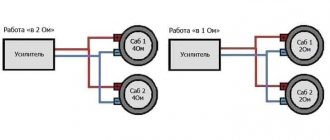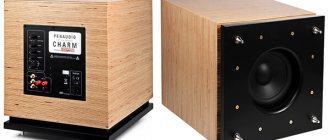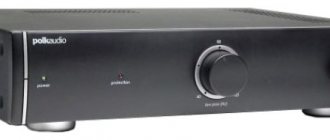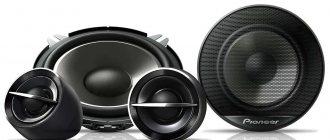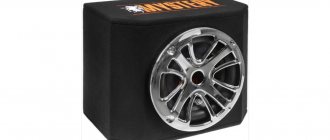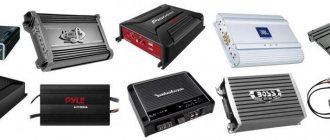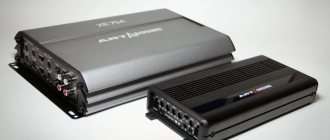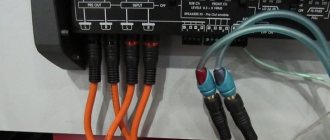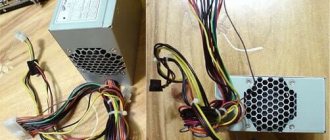In this article we will look at how to properly connect the speakers to the amplifier, and what to proceed from when selecting the components of the amplifier - speaker cable - speaker system.
If you have any questions, ask them here.
AuI ConverteR 48×44 - HD audio converter for high-resolution music files FLAC, WAV, WAV/BWF, WAV/RF64, AIF, AIFF, AIFF/sowt, ALAC, mp3, OGG, AAC, WMA, DTS, AC3 CD ripper ( for Mac OS X and Windows)
How to choose and buy an acoustic cable for speakers.
Diagram for connecting a receiver or amplifier to speakers.
Connecting a subwoofer. Installation, configuration.
Receiver or amplifier?
What do speaker characteristics mean?
What do amplifier characteristics mean?
Theory and practice - how to select speakers for an amplifier, matching the amplifier and speakers
Which speakers to choose (types of speakers, simple techniques for listening to speakers and multi-channel systems [5.1, 6.1, 7.1], correct installation in the room)
Sound cards for music (how to choose and connect to an amplifier or receiver)
Connection diagram of the receiver or amplifier to the speakers
Let's look at how to properly connect a stereo audio amplifier for speakers to passive speaker systems. Connecting multi-channel systems is carried out in the same way. The only difference is the number of columns. By
Biamping and bi-waring
Bi-amping is the connection of high-frequency and mid-low-frequency speakers to two separate amplifiers. Allows in some cases to better match the speaker and amplifier by increasing the load on the amplifier. In the case of a standard (parallel) connection of both speakers of a speaker, their total resistance (total resistance of the speaker) is less than the resistance of any of the speakers. A positive result is not guaranteed.
Bi-amping is the connection of each speaker speaker system to its own amplifier. A crossover allows you to more accurately place amplifiers and speaker speakers exactly in the specific area where they will work in tandem with the best performance. A similar circuit is used in studio monitors (the amplifiers are built into the monitor body)
Bi-wiring is the connection of high-frequency and mid-low-frequency speakers to one amplifier with two separate wires. Allows in some cases to better match the speaker and amplifier by reducing the resistance of the wires (relative to the resistance of the speaker). A positive result is not guaranteed.
Bi-wiring (bi-waring) we connect each speaker with its own wire to the amplifier. Very controversial sound improvement
Characteristic indicators of video playback
The Pioneer vsx receiver of virtually the entire lineup supports 4K/60p/4:4:4/24 and 4K/24p/4:4:4/36-bit signals. As a result, a 4:4:4 palette of bright signals is turned on. Each device is ready to transmit 4K video signals on consistent signals.
In addition to other advantages, the video converter built into the device will allow you to convert a composite video signal and S-Video into a component signal with sweep or convert absolutely any type of analog video signal from HDMI digital. In other words, when connected:
- DVD;
- PC;
- Blu-Ray;
- game consoles;
- video camera or media player to different video connectors of the AV receiver to get an image, you just need to use one HDMI cable. An HDMI cable is used to connect the video input of a projector, plasma, LCD or other equipment.
Still, it is worth considering that a typical function is inherent in models with a higher price point and higher class.
What to choose: receiver or amplifier?
A receiver is an amplifier additionally equipped with a radio receiver and a decoder (decoder) of multi-channel signals encoded in different formats (Dolby D, DTS, etc.).
If we are going to watch a movie , then we can either take a receiver, or take a decoder and several (according to the total number of channels) stereo or mono amplifiers.
There is an opinion that to listen to music . It introduces less distortion with all sorts of additional devices. But it is not always the case. Here, as usual, the question is price. The cost of an amplifier/receiver should be approximately (not a truism) 40 - 100% of the cost of a set of acoustics (not including a subwoofer).
Switching Interfaces
The most popular modifications from Yamaha allow you to connect with almost any type of content sources. For this, several connection interfaces are used:
- RCA – analog stereo channel;
- S/PDIF or TOSLINK – digital multi-channel audio;
- S-Video – standard definition without audio;
- SCART – image and audio (obsolete format);
- RCA – component video;
- HDMI – image and multi-channel sound.
Important! In order to get the highest quality analog video, it is better to use component connectors.
Amplifier Specifications
In this article (when we are talking about connecting speakers to an amplifier) we are talking about power amplifiers. They are characterized by the following parameters:
1) Maximum output power is the achievable output power of the amplifier at a non-standardized nonlinear distortion factor.
2) Nominal output power is the power level at which the amplifier provides the specified total harmonic distortion.
3) Nonlinear distortion factor - the level of parasitic signals mixed with the original (clean) signal when passing through the amplifier.
Manufacturers play with these values in promotional materials, so it will be useful to know the types of powers that are found in the description of amplifiers:
I) RMS (Root Mean Squared) - power value (rms or root - this is a way of measuring power with electrical measuring instruments) at a given nonlinear distortion factor . The measurement is usually carried out on a 1 kHz signal. The power is pumped until the THD reaches 10%. Before reaching maximum power, the nonlinear distortion factor is usually very small, and after reaching it it increases sharply.
II) PMPO (Peak Music Power Output) - the maximum permissible peak (pulse) value of the signal, regardless of distortion, for a minimum period of time (usually 10 milliseconds). This parameter has no meaning for practical use, because The measurement is carried out over a very short period of time and does not take into account distortions. For example, in boomboxes PMPO can reach 100 and 1000 W. But this is not “honest” power. RMS can be 3-10 W.
III) DIN POWER ( IEJA ) - the value of the maximum power at a real load at a given nonlinear distortion factor . Measurements are carried out for 10 minutes for a sinusoidal signal with a frequency of 1000 Hz with a nonlinear distortion coefficient not exceeding 1%.
IHF is the same, with a total harmonic distortion of 0.1%.
This type of power measurement most “correctly” characterizes the amplifier from the consumer’s point of view.
4) Frequency range is the values of the lowest and highest frequencies of the amplifier’s output signal, at which the level of this signal fluctuates within specified limits (for hi-fi, about +/- 0.5-1 dB).
Connecting everything
Congratulations, you have purchased an amplifier! It's time to connect everything.
The sheer number of connections on the back of any amplifier can be daunting, but take the time to get it all set up correctly in one go and you'll never have to do it again.
We recommend keeping your amplifier turned off when you connect your speakers, subwoofer, and sources. This will prevent any popping noises, short circuits, or any other possible damage to your system.
Most, if not all, amps have everything clearly marked. Some, like Denon amplifiers, make it easy to connect five (or more) pairs of speakers by color-coding their speaker terminals. The surround back, front panel height or width speaker terminals can also be used as Dolby Atmos speaker terminals: they can be labeled "assignable", "5.1.2 channel" or "Extra SP".
If you'll be playing 4K HDR content, look for the "HDCP2.2" label above the HDMI inputs. In some cases, only a pair of HDMI inputs will be HDCP2.2 certified - make sure you connect your 4K Blu-ray player to them.
You'll also notice that each HDMI input has a source assigned to it: Blu-ray, DVD, CD, Game, CBL/SAT, media player, and so on. This is not just friendly guidance. This means that the manufacturer has taken care to optimize these inputs for these specific sources. For example, a Blu-ray input may offer the shortest signal path to the processor and thus provide the best performance.
Two more connections worth talking about: We would recommend using a wired Ethernet connection whenever possible, as it is more stable and reliable than Wi-Fi.
What about the USB port on the front? It will play media from a USB drive, but we find it useful for charging our smartphones (if the amp allows it).
- Best Speaker Cables: Budget vs Premium Audio Cables
How to choose speakers for an amplifier (practice)
Home acoustics
Buyers of audio equipment select passive acoustics, wires, and amplifiers by ear. But this is more of an art than a precise method. And the optimal result of such a selection (for home acoustics) is not an even volume across all frequencies, but an acceptable (pleasant to the ear) sound.
If you look at the technical characteristics of the amplifier and speakers, you need to consider the following:
1) If you have chosen speaker systems, then the amplifier must be designed to work with speakers with the same input impedance.
Amplifiers usually have mechanical or electronic speaker impedance (resistance) switches. Before using the speakers, they must be moved to a position that matches the impedance of your speaker systems.
What can result from a discrepancy between the speaker impedance and the nominal (for which the amplifier is designed) load (connected speakers) of the amplifier? In the worst case, the amplifier fails. And in the usual case, to much worse sound quality. Because The frequency matching of the amplifier and speaker systems deteriorates.
2) The receiver amplifier must provide a power of at least 33% of the maximum power of the speakers. The thicker the wires, the better (with a cross-section of at least 1.5 mm2). And the rest is selected solely by ear.
Studio equipment
For musical (studio) equipment—studio monitors—a different method is predominantly used. Mainly active (with built-in amplifier) acoustics are used. This allows you to completely get rid of speaker cables and, in the factory, to maximally equalize the frequency response of the speaker system (speaker + amplifier).
The technique is approximately as follows:
In an anechoic soundproof room, the frequency response of the pressure is measured using a verified (tested and certified by the relevant authorities) sound pressure meter and signal generator. Sound pressure is measured at different sound frequencies at a constant signal level at the amplifier input. By selecting radio elements of the amplifier circuit and frequency filters of the active acoustic system, as well as adjusting the settings, it is possible to achieve the same sound pressure at different frequencies.
How to install and connect a 5.1 home theater
Installing and connecting a 5.1 home theater with your own hands is not difficult if you follow the instructions. First, connect the speakers to the receiver, and then the receiver to the TV.
Connecting speakers and receiver
The first thing you need to do is to correctly place the components in the apartment.
Front speakers are installed to the left and right of the screen. The central speaker is hung above or below the TV, opposite the viewer. The rear speakers are placed behind the person sitting on the left and right and are rotated towards him at an angle of 45°. The subwoofer is usually located behind or next to the TV set, but it has omnidirectional sound, so variations are possible.
It is best to listen to the subwoofer at different points and choose the optimal one.
The acoustics are connected to the receiver using the cable included in the kit. Two types of connectors are used for connection: push and threaded. In the first case, you need to press the button, open the connector and insert the wire.
The cable consists of two multi-colored wires; they are connected according to color. For a threaded connection, unscrew the cap of the desired color, wind the wire in a circular motion, and then return the cap to its original place. When connecting acoustics to the receiver, it is important not to make mistakes and connect the speakers correctly.
The front ones are combined with the connector marked “Front”, the rear ones are “SURROUND”, the subwoofer is “SUBWOOFER”.
Connecting the receiver to a TV
To connect the home theater set with receiver to the TV, a video cable is used; it is selected depending on the available connectors. If both devices have HDMI inputs and outputs, it is better to use them. This connection ensures the best image quality. If one of the devices does not have an HDMI connector, a “component” connection is selected. To do this, use a cable with three plugs in red, blue and green. They are connected to connectors of a similar color. The signal quality in this case will be high. A SCARD cable will provide the same; it can also be used if the appropriate ports are available.
S-Video is another format that can be used to transmit video signals.
It is considered obsolete and is quite rare on modern technology, but, if available, it can be used. The simplest and least quality type of connection is the “tulip” cable, also known as Video. The connection is made with a yellow wire with an RCA connector. When connecting equipment, regardless of the type of cable, you need to connect the wire on the receiver to the connector marked “ OUT ”, on the TV – marked “ IN ”. The equipment must be turned off during these actions. After turning it on, you need to take the control panel and select the connector to which the cable is connected in the list of signal sources. If an image from a home theater appears on the screen, it means that all steps were performed correctly.
Outputting sound from TV
If the sound quality in the TV speakers does not suit the user, the audio signal can be output to 5.1 speakers. There are several types of cable that can solve this problem. The best solution is to use fiber optic cable. It is capable of transmitting digital multi-channel audio. The wire is connected to the Optical OUT and Optical IN on the TV and receiver, respectively.
If such outputs are not available, you can use a coaxial cable; to use it, the Coaxial OUT and Coaxial IN ports are required. The most inexpensive and lowest quality of the transmitted signal is a 2 RCA analog cable, at the end of which there are two red and white plugs.
It is not recommended to use it, because the sound quality with this connection is very poor. To set up the connection, you need to find the Audio IN and Audio Out connectors on your home theater and TV receiver. If the listed outputs are not available, the headphone jack on the TV is used. In this case, you will need a mini Jack 3.5 mm - 2 RCA cable.
How to choose speakers for an amplifier (theory)
We use this sound reproducing equipment for the following purposes:
1) Listening to music
2) Watching a movie
3) Music creation (monitoring, mixing)
For sound equipment used to create music, the main thing is to introduce a minimum of distortion into the reproduced phonogram.
For household audio equipment, it is more permissible to introduce some distortion, which can even embellish the sound. That's why there is an opinion that one system is more suitable for heavy metal, another for electronic music, a third for jazz, and a fourth for classical music.
However, for high-quality studio monitors (speakers used in the studio when creating a musical soundtrack), the question should not arise at all: for what style are these monitors more suitable? Yes, for anyone!
Ideally the system
amplifier - speaker cable - speakers
should not introduce any distortion into the sound of the soundtrack, which was recorded in the studio based on the sound of high-quality monitors. The musicians and sound engineer tuned the sound of the musical piece in such a way as to replicate its emotional impact on household acoustics.
The listener's ears perceive the sound pressure of the air.
Acoustic systems create this sound pressure.
Acoustic systems, in turn, convert the electrical signal of a phonogram (musical recording) into air sound pressure. The dependence of sound pressure on the ears (loudness) on the frequency of sound (note pitch) - let's call it the frequency response of the sound pressure of the speakers (or the frequency response of the sensitivity of the speakers) .
If we apply a signal with the same voltage to the input of the speakers (let it be 5 Volts) at different frequencies (we play notes of different heights), then the volume of the sound of different notes will be different , because The E of the 1st octave will create, for example, a pressure of 1, the E of the 3rd octave will create 2, and the E of the 6th octave will create 0.5. The pressure values are conditional.
We can conclude:
Even if we have an ideal amplifier that produces the same electrical signal voltage over the entire audio range (for any musical note), then the sound pressure (sound volume) of the real acoustics connected to this amplifier will still be different for different frequencies (notes) .
Press play
When we test an AV receiver, we let it "run" (i.e. leave it on for a day or two) to get it sounding its best before critical listening. Since you will live with your amp, you will find that the more you use it, the better it sounds.
What are you waiting for? Watch your favorite movie, grab a bite to eat, and enjoy your new, perfectly configured home theater.
Before we move, here are some general AV tips:
- AV receivers are large and heavy objects, so give your amplifier plenty of room on the AV rack.
- Make sure there is enough ventilation. too, as it may become warm during playback.
- Keep the display turned off to improve sound quality.
- Smartphone apps can be good, but we prefer a reliable physical remote control. Bonus points if the remote is backlit.
- Look through each individual folder and subfolder in the amp's menu and you'll find plenty of useful settings hidden away.
- Use quality speaker cables and HDMI cables to get the most out of your system.
- Try not to get the speaker cables too tangled with each other to reduce any interference.
- Check regularly for software updates.
- Ignore the wattage rating given by the manufacturer. Each manufacturer measures them differently, so the results can be misleading. It may be tempting to go for the highest number (200W, for example), but an AV receiver's power rating doesn't accurately reflect performance.
- Top tip: Before you sit down and watch a movie at night, turn on the AV receiver about half an hour earlier to warm it up - it will sound much better than if you started playing it in cold weather.
Model overview
We offer a description of the most popular receivers from Yamaha.
Black RX-V385
A modern discrete AV receiver model has a high quality DAC. The receiver is five-channel – 5.1, compatible with Bluetooth. Equipped with a DSP system that facilitates the reproduction of HD Audio Dolby TrueHD, DTS-HD Master Audio TM and others. Reproduces and enhances natural sound - you can feel the acoustic properties of medieval cathedrals and other famous places in your home.
YPAO (Yamaha Parametric room Acoustic Optimizer) optimizes and studies the echoes of your home environment , then adjusts various parameters as closely as possible for good sound delivery. To do this, you just need to attach the microphone in listening mode, turning on YPAO, and the system will adjust itself for the best performance of your equipment.
This model focuses on achieving absolutely clear and high quality sound. It uses a low jitter PLL and discrete amplifier configuration. This favorably contributes to excellent sound quality.
The Bluetooth function plays music wirelessly from various devices and smartphones. Thanks to Compressed Music Enhancer, audio is reproduced via Bluetooth.
Article on the topic: Is it necessary to install an ouzo on a washing machine?
Full 4K Ultra HD support. The model is perfectly compatible with new HDMI standards, 4K video transmission speed is 60 frames per second. Full immersion and expansion comes with an improved sound return channel. The eARC protocol provides multi-channel audio formats over HDMI connections and delivers audio so real and expansive that you'll be transported into virtual reality when watching videos.
Thanks to the Bi-amp Connection function, the receiver can drive frequency ranges of speakers and independent amplifiers. It prevents interference between high and low sounds, improving the sound performance of the front speakers and ensuring their power.
Thanks to the on-screen display, it is possible to view complete information about the music track in several languages. A special application makes it easy to use the equipment - there is a guide to setting up AV. To save energy by 20%, the ECO Mode function is provided. Full specifications of the model are presented in the instructions.
RX-V585
This is a 7.2 channel receiver that comes with the latest networking features. Thanks to Dolby Atmos and DTS:X, the sound becomes acoustic and realistic, transporting you to a magical world of unforgettable emotions.
Cinema DSP 3D is a patented technology created by combining enhanced sound field data. Specialists from Yamaha specifically traveled to various concert halls, collecting information from different continents. They've digitized this entire data stream and put it into certain LSI devices that replicates the entire concert hall space in your home.
Article on the topic: How to set up sound via hdmi on an lg TV
YPAO TM studies the acoustics in your room and then tunes itself for the best sound. To do this, you just need to turn on the microphone in the YPAO position, and it will adjust itself to work in your conditions.
Sound distortion is kept to a minimum thanks to discrete power amplifiers. Only good primary power supplies are used for analog and digital circuits.
If you connect MusicCast speakers to the receiver, you will enjoy only beautiful and real sound.
By connecting all your devices to the same network, you can share audio throughout your home. For a test drive, you can download the MusicCast application and use it in demonstration mode. With AirPlay 2, you can stream Apple Music and other services to many MusicCast devices throughout your home. You can also control them from your smartphone or iPhone. The Virtual Presence Speaker option and the power of Cinema DSP 3D make full use of the speakers to create audio data , while eARC provides high-resolution audio formats for many channels via HDMI connectors.
The device provides you with rich, expansive and realistic sound for watching movies. There are two options for controlling the receiver. This is touch control or voice control.
RX-V777
This AV receiver from the budget RX-V series has excellent functionality at the best price. Is the center of your home entertainment system. The model has a strict classic design, the front panel is visually divided into two halves. The top one has a glass surface for the information display. The lower metal part is equipped with volume controls and selector inputs. There are 4 line inputs and one for a vinyl record player. There are also separate intermediate 7.2 outputs for sound reproduction of an additional zone.
Article on the topic: How to install air conditioning on a Kamaz
The presence of 6 HDMI version 2.0 inputs can increase picture expansion up to 4K. Output amplifiers operating in class AB are assembled using discrete elements. With a 4 ohm load, even one channel can output about 160 watts.
Thanks to the Cinema DSP program, unreal sound reproduction occurs if there is a subwoofer and two front channels. The subwoofer is equipped with Bluetooth, the equipment can work with AirPlay, MHL, HTC Connect and DLNA.
Thanks to the special AV Controller application, settings can be simplified and carried out using a smartphone.
Modern graphics will be able to select digital signal processing settings and create their own sound field models. A control panel is included with the receiver.


